Interspinous posterior devices: What is the real surgical indication?
- PMID: 25232541
- PMCID: PMC4163760
- DOI: 10.12998/wjcc.v2.i9.402
Interspinous posterior devices: What is the real surgical indication?
Abstract
Interspinous posterior device (IPD) is a term used to identify a relatively recent group of implants used to treat lumbar spinal degenerative disease. This kind of device is classified as part of the group of the dynamic stabilization systems of the spine. The concept of dynamic stabilization has been replaced by that of dynamic neutralization of hypermobility, with the intention of clarifying that the primary aim of this kind of system is not the preservation of the movement, but the dynamic neutralization of the segmental hypermobility which is at the root of the pathological condition. The indications for the implantation of an IPD are spinal stenosis and neurogenic claudication, assuming that its function is the enlargement of the neural foramen and the decompression of the roots forming the cauda equina in the central part of the vertebral canal. In the last 10 years, use of these implants has been very common but to date, no long-term clinical follow-up regarding clinical and radiological aspects are available. The high rate of reoperation, recurrence of symptoms and progression of degenerative changes is evident in the literature. If these devices are effectively a miracle cure for lumbar spinal stenosis, why do the utilization and implantation of IPD remain extremely controversial and should they be investigated further? Excluding the problems related to the high cost of the device, the main problem remains the pathological substrate on which the device is explicit in its action: the degenerative pathology of the spine.
Keywords: Interspinous distraction; Interspinous fusion device; Interspinous posterior device; Minimally invasive surgery; Motion preservation surgery; Spine surgery.
Figures


Similar articles
-
Greater than 5-year follow-up of outpatient L4-L5 lumbar interspinous fixation for degenerative spinal stenosis using the INSPAN device.J Spine Surg. 2020 Sep;6(3):549-554. doi: 10.21037/jss-20-547. J Spine Surg. 2020. PMID: 33102891 Free PMC article.
-
[Treatment of dynamic spinal canal stenosis with an interspinous spacer].Oper Orthop Traumatol. 2010 Nov;22(5-6):524-35. doi: 10.1007/s00064-010-9042-5. Oper Orthop Traumatol. 2010. PMID: 21153010 German.
-
Interspinous spacer decompression (X-STOP) for lumbar spinal stenosis and degenerative disk disease: a multicenter study with a minimum 3-year follow-up.Clin Neurol Neurosurg. 2014 Sep;124:166-74. doi: 10.1016/j.clineuro.2014.07.004. Epub 2014 Jul 14. Clin Neurol Neurosurg. 2014. PMID: 25064150 Clinical Trial.
-
A Comprehensive Review of Novel Interventional Techniques for Chronic Pain: Spinal Stenosis and Degenerative Disc Disease-MILD Percutaneous Image Guided Lumbar Decompression, Vertiflex Interspinous Spacer, MinuteMan G3 Interspinous-Interlaminar Fusion.Adv Ther. 2021 Sep;38(9):4628-4645. doi: 10.1007/s12325-021-01875-8. Epub 2021 Aug 14. Adv Ther. 2021. PMID: 34398386 Review.
-
Interspinous distractor devices for the management of lumbar spinal stenosis: a miracle cure for a common problem?Br J Neurosurg. 2012 Aug;26(4):445-9. doi: 10.3109/02688697.2012.680630. Epub 2012 May 15. Br J Neurosurg. 2012. PMID: 22582741 Review.
Cited by
-
Comparison of long-term outcomes of spinal fusion surgeries supplemented with "topping-off" implants in lumbar degenerative diseases: A systematic review and network meta-analysis.N Am Spine Soc J. 2022 Oct 22;12:100177. doi: 10.1016/j.xnsj.2022.100177. eCollection 2022 Dec. N Am Spine Soc J. 2022. PMID: 36394053 Free PMC article. Review.
-
Biomechanical changes of degenerated adjacent segment and intact lumbar spine after lumbosacral topping-off surgery: a three-dimensional finite element analysis.BMC Musculoskelet Disord. 2020 Feb 15;21(1):104. doi: 10.1186/s12891-020-3128-5. BMC Musculoskelet Disord. 2020. PMID: 32061252 Free PMC article.
-
Lumbar spinal degenerative "microinstability": hype or hope? Proposal of a new classification to detect it and to assess surgical treatment.Eur Spine J. 2015 Nov;24 Suppl 7:872-8. doi: 10.1007/s00586-015-4274-6. Epub 2015 Oct 20. Eur Spine J. 2015. PMID: 26487473
-
Spinal motion preservation surgery: indications and applications.Eur J Orthop Surg Traumatol. 2018 Apr;28(3):335-342. doi: 10.1007/s00590-017-2052-3. Epub 2017 Oct 6. Eur J Orthop Surg Traumatol. 2018. PMID: 28986691 Review.
-
Coflex Interspinous Stabilization with Decompression for Lumbar Spinal Stenosis: An Average 14-Year Follow-Up.J Clin Med. 2025 Apr 21;14(8):2856. doi: 10.3390/jcm14082856. J Clin Med. 2025. PMID: 40283686 Free PMC article.
References
-
- Przybyla AS, Skrzypiec D, Pollintine P, Dolan P, Adams MA. Strength of the cervical spine in compression and bending. Spine (Phila Pa 1976) 2007;32:1612–1620. - PubMed
-
- Shirazi-Adl A. Analysis of large compression loads on lumbar spine in flexion and in torsion using a novel wrapping element. J Biomech. 2006;39:267–275. - PubMed
-
- Gillespie KA, Dickey JP. Biomechanical role of lumbar spine ligaments in flexion and extension: determination using a parallel linkage robot and a porcine model. Spine (Phila Pa 1976) 2004;29:1208–1216. - PubMed
-
- Adams MA, Hutton WC, Stott JR. The resistance to flexion of the lumbar intervertebral joint. Spine (Phila Pa 1976) 1980;5:245–253. - PubMed
-
- Gudavalli MR, Triano JJ. An analytical model of lumbar motion segment in flexion. J Manipulative Physiol Ther. 1999;22:201–208. - PubMed
LinkOut - more resources
Full Text Sources
Other Literature Sources

